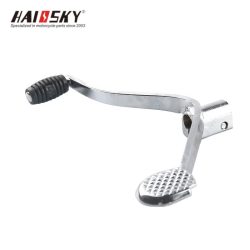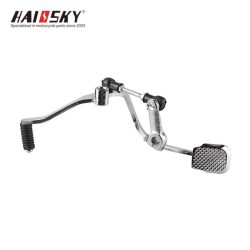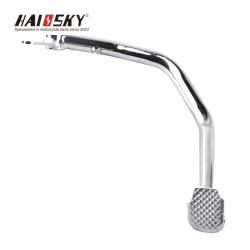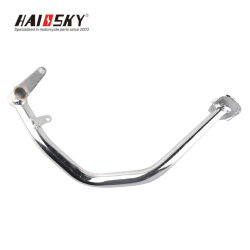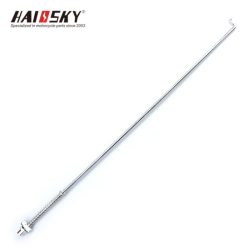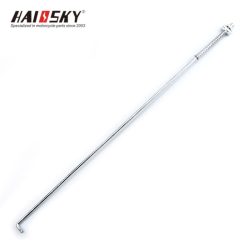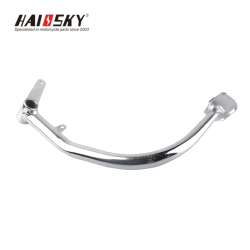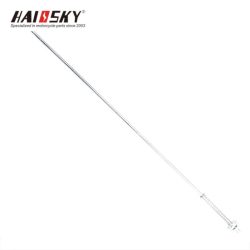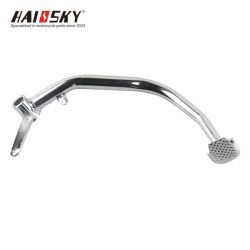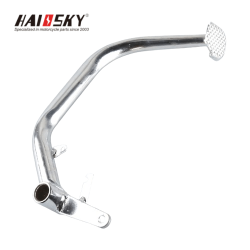OEM Motorcycle Parts
Category: Motorcycle Brake Pedals - Adjustable Rods
About Motorcycle Brake Pedal & Rod
The motorcycle brake pedal and rod are critical components of a motorcycle’s braking system, ensuring safe and efficient stopping power. The brake pedal is the interface between the rider and the braking mechanism, while the brake rod (or linkage) transmits the force from the pedal to the brake system. Together, they play a vital role in controlling the motorcycle’s speed and ensuring rider safety. Whether you’re a wholesaler, mechanic, or enthusiast, understanding the intricacies of these components is essential for optimizing performance and durability.
Types of Motorcycle Brake Pedals & Rods
The design and functionality of motorcycle brake pedals and rods vary depending on the type of braking system and the motorcycle model. Below are the most common types:
1. Standard Brake Pedal with Rod
This is the most common setup, found in motorcycles with drum or disc brake systems. The brake pedal is connected to the brake rod, which transfers the force to the brake mechanism. When the rider presses the pedal, the rod pushes or pulls the brake components, activating the brakes. These are typically made from durable materials like steel or aluminum for strength and longevity.
2. Adjustable Brake Pedal Assembly
Some modern motorcycles come with adjustable brake pedal assemblies. These allow riders to customize the height and reach of the brake pedal, ensuring a comfortable and ergonomic riding experience. The brake rod in these assemblies is often adjustable in length, making it easier to fine-tune the braking response.
3. Hydraulic Brake Pedal Systems
In motorcycles with hydraulic braking systems, the brake pedal is connected to a master cylinder instead of a rod. When the pedal is pressed, hydraulic fluid is pushed through the brake lines, activating the brake calipers. While these systems don’t use a traditional brake rod, they still rely on a pedal mechanism for operation.
4. Off-Road Brake Pedals & Rods
Off-road motorcycles often feature reinforced brake pedals and rods designed to withstand rough terrain and extreme conditions. These components are typically made from high-strength materials like titanium or carbon fiber to ensure durability and lightweight performance.
Materials Used in Motorcycle Brake Pedals & Rods
The materials used in manufacturing brake pedals and rods significantly impact their performance, durability, and weight. Here are the most common materials:
Steel: Known for its strength and durability, steel is the most widely used material for brake pedals and rods. It can withstand high stress and is resistant to wear and tear.
Aluminum: Lightweight and corrosion-resistant, aluminum is often used in high-performance motorcycles. It offers a good balance between strength and weight.
Titanium: Titanium is extremely strong, lightweight, and corrosion-resistant, making it ideal for premium and off-road motorcycles. However, it is more expensive than steel or aluminum.
Carbon Fiber: While not as common, carbon fiber is used in high-end motorcycles for its lightweight and aesthetic appeal. However, it is less durable than metal options.
Specifications and Maintenance of Motorcycle Brake Pedals & Rods
Specifications
Brake Pedal Length: Typically ranges from 100 mm to 150 mm, depending on the motorcycle model.
Brake Rod Length: Usually between 150 mm and 250 mm, with adjustable options available for customization.
Diameter: The brake rod diameter is typically 8 mm to 12 mm, balancing strength and ease of operation.
Maintenance Tips
Regular Inspection: Check the brake pedal and rod for signs of wear, corrosion, or damage. Inspect the pivot points and connections for smooth operation.
Lubrication: Apply a high-quality lubricant to the pivot points and joints to reduce friction and prevent wear.
Adjustment: Ensure the brake pedal height and rod length are properly adjusted for optimal braking performance.
Cleaning: Keep the brake pedal and rod clean by removing dirt, dust, and debris with a soft brush or damp cloth.
Replacement: Replace any worn or damaged components immediately to maintain braking efficiency and safety.
How to Choose the Right Motorcycle Brake Pedal & Rod
Selecting the right brake pedal and rod for your motorcycle depends on several factors:
Motorcycle Type and Riding Style: Sport bikes, cruisers, and off-road motorcycles have different braking requirements. Choose components that match your motorcycle’s design and your riding style.
Material: Consider the material based on your performance needs and budget. Steel is durable and affordable, while titanium offers premium performance at a higher cost.
Adjustability: Opt for adjustable brake pedals and rods if you need to customize the braking feel and reach.
Compatibility: Ensure the brake pedal and rod are compatible with your motorcycle’s make and model.
Budget: High-quality components may cost more but offer better performance and longevity.
How to Adjust and Replace Motorcycle Brake Pedals & Rods
Adjusting the Brake Pedal
Locate the adjustment nut or bolt on the brake rod.
Loosen the locknut and turn the adjustment nut to change the brake pedal height or rod length.
Tighten the locknut once the desired adjustment is achieved.
Test the brake pedal to ensure smooth operation.
Replacing the Brake Pedal & Rod
Preparation: Gather the necessary tools, including wrenches, pliers, and a repair manual for your motorcycle.
Remove the Old Components: Disconnect the brake rod from the pedal and brake mechanism. Remove the pedal by loosening the mounting bolt.
Install the New Components: Attach the new brake pedal and rod, ensuring all connections are secure.
Adjust and Test: Adjust the brake pedal height and rod length as needed. Test the brakes to ensure proper functionality.
Frequently Asked Questions (FAQ)
Q: What is the best brake technique for a motorcycle?
A: The best braking technique involves using both the front and rear brakes simultaneously. Apply gradual pressure to avoid locking the wheels, and use the front brake for 70% of the stopping power and the rear brake for the remaining 30%.
Q: What side is the brake and clutch on a motorcycle?
A: In most motorcycles, the brake pedal is on the right side, and the clutch lever is on the left handlebar. The front brake lever is on the right handlebar.
Q: How do you adjust the brake lever tension on a motorcycle?
A: Locate the adjustment screw or dial on the brake lever. Turn it clockwise to increase tension or counterclockwise to decrease tension. Test the lever to ensure it feels comfortable and responsive.
Q: What are the components of motorcycle brakes?
A: The main components include the brake pedal, brake rod, master cylinder, brake calipers, brake pads, brake discs (or drums), and brake lines.
Q: What side is the brake pedal on a motorcycle?
A: The brake pedal is typically on the right side of the motorcycle, near the footrest.
Q: Is the motorcycle clutch left or right?
A: The clutch lever is on the left handlebar, while the front brake lever is on the right handlebar.
By understanding the importance of motorcycle brake pedals and rods, you can make informed decisions when purchasing, maintaining, or replacing these components. At Haissky.com, we offer a wide range of high-quality brake pedals and rods designed to meet the needs of every rider. Explore our collection today and ensure your motorcycle’s braking system is in top condition!


